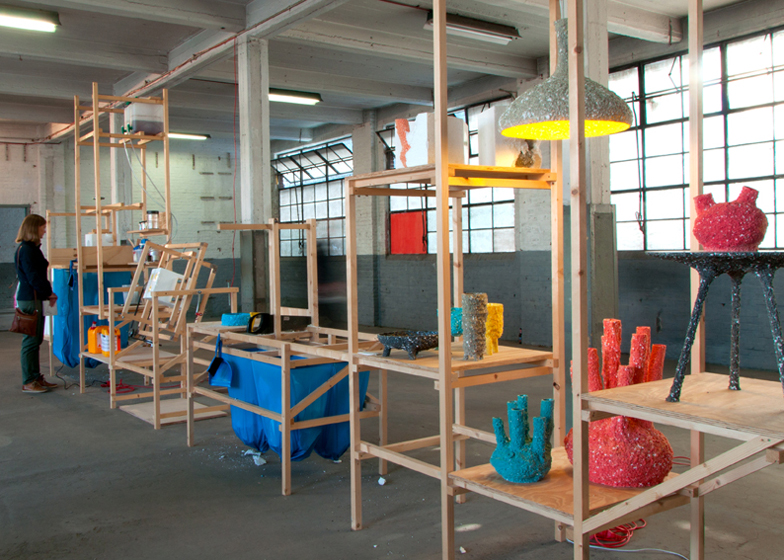Dutch Design Week: twenty-five designers set up their own production lines inside a former textile factory in the Netherlands last week, making furniture, lighting, clothes, shoes, food, paper and more with the help of visitors.
Above: The Invisible Line by Francesco Zorzi, using heated tools to make monochrome drawings on thermal paper.
Curators and initiators of the C-Fabriek project Itay Ohaly and Thomas Vailly invited designers to create their own production lines, machines, tools and products for what they call "the New Factory."
Above: CONSUMER LABORatory by Joong Han Lee and Thomaz Bondioli, involving customers in the customisation and production of jewellery.
Each installation is a combination of studio, factory and shop where consumers can watch and collaborate on the manufacture of their goods.
Above: Printing Lab – An adventure in Graphic Design & Manual Printing by Olivia de Gouveia, an open printmaking workspace where participants print their own image of a factory.
"C-fabriek is a place where designers work, create and manufacture, but also present their processes and methods to the public," say Ohaly and Vailly. "By doing so, they are reclaiming control over their creations and suggesting alternatives to industrialisation, production and consumption."
Above: Creative Factory Line01 by Itay Ohaly, moulding objects inside polystyrene packaging.
Ohaly's own Creative Factory Line01 makes objects like lamps, vases and stools by drilling into a block of polystyrene to make a mould, which is then filled with resin and rotated in a spinning frame as it hardens.
Above and below: Creative Factory Line02 by Thomas Vailly, using rotational moulding to make objects inside stretched latex.
The mould doubles as packaging and is hacked away by the customer once they get the product safely home.
Vailly's Creative Factory Line02 also makes use of rotational moulding, this time creating resin objects inside a stretched and inflated latex mould.
Above: Inner Fashion Line. Product and context design by Laura Lynn Jansen, process design by Thomas Vailly. A tight inner stretchy fabric and a loose non-stretchy outer fabric are pulled over an inflated balloon then bonded in selected places with glue. Once removed from the former, the bonded points gather the fabric to shape a garment.
There was also a paper mill recycling newspaper and leaflets from the city called the Paper Poo Machine, a food preserving machine, a fashion house making garments by gathering fabric with dots of glue and a human fax machine making prints on thermal paper with heated tools.
Above and below: FootMade – Custom made shoes by Eugenia Morpurgo, shaping shoes around the customer's feet using connectors that replace glue and stitching in the shoe's construction.
C-Fabriek took place at the Schellensfabriek as part of Dutch Design Week from 20 to 28 October.
Meanwhile, downstairs in the same building, architect Brian Peters was making bricks from 3D printed ceramic.
Above and below: Paper Poo Machine by Parasite9, a paper mill recycling the city's waste newspapers and leaflets.
See all our stories about Dutch Design Week.
Photographs are by Kim Costantino and Christian Fiebig.
Above: Foodconvertors by Lucas Mullié & Digna Kosse, table-sized factories for preserving and preparing food at the same time in a kitchen where the food practically prepares itself.
Above: Impulsive Furnishing Unit. CNC machine by Christian Fiebig, concept and furniture by Itay Ohaly and Thomas Vailly. A whole furniture factory reduced to the size of a standardized plywood palette, which can be shipped and used anywhere. This machine was used to make the furniture found throughout the C-Fabriek exhibition.
Above: An element of time by Juan Montero, a clock that produces and destroys a ceramic object in a 24 hour cycle.
Above: Shaping Sugar by Amelia Desnoyers, a production line treating molten sugar like glass.
Above: Shaping bodies by Bas Geelen and Erik Hopmans, reintroducing the physical exercise to factories that's been lost with the introduction of more automated production lines.
Click above for larger image
Click above for larger image
Click above for larger image

